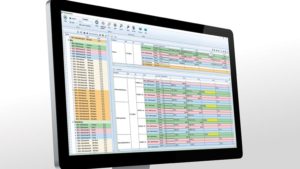Five Guidelines to Investing in Software for Your Greenhouse
 “Is the juice worth the squeeze? Each innovation should pass the squeeze test before you decide to implement it.”
“Is the juice worth the squeeze? Each innovation should pass the squeeze test before you decide to implement it.”
The quote above from Ken VanWingerden at ColorPoint refers to getting the most out of your software. In other words, are you using your software effectively? Is your software increasing your efficiencies, lowering your costs, increasing your margins? Are you getting the most value as possible from your technology? Do you know when to invest in software tools?
Aaron Allison, Founder of SBI Software, has been in the grower and software industries his entire adult life and has worked exclusively with grower clients. He recommends that growers invest 4% to 6% of their annual revenue in technology to have a competitive edge in this industry.
Quite often, Allison is asked the same who-what-when-why-how plethora of software investment questions. In response, he offers five guidelines to consider when investing in software solutions.
1) Is the Juice Worth the Squeeze?
The majority of improvements that you make to your software should pass the “squeeze” test. In other words, any software improvement should make sense for your team and be worth the investment. At any given time you might have 50 things you could do to your software to improve it, but how many of those changes will really have a true impact? Enhancements should only be implemented if you answer “yes” to the following questions: Will we ship more at lower costs? Will we ship more in less time?
Any time you decide to upgrade or improve your software, you should be doing so to solve an existing problem.
2) Software is Not a One-Time Capital Expenditure
Your software is an investment in your business, and is always evolving. It’s not stagnant. You should include software innovations in your recurring monthly and annual budget. If you want to continuously grow and improve your business, you must make ongoing investments in the software that supports you in running your business. As long as you are running a prosperous company, there will never be a point in time that your software is finished.
Your operation will grow and change, as will your software needs. Innovating your software will lead to more simplified tasks and improved margins. New production methods will require enhanced features. Updates will be needed.
3) Software Innovation Should Not be Restricted by Accounting
The majority of business software is bean counter software, meaning it is accounting-focused. Accounting is vital for bookkeeping purposes, but widget-based business software often causes critical bottlenecks in change orders, order fulfillment, and shipping, departments that are the most crucial to the growth and survival of your company as a whole. Tracking costs and managing the budget is important, but not if it costs 10 cents to find out that you are losing 1 cent.
The tools you use on a daily basis to run your operation should do much more than a shiny calculator. They should help drive sales, reduce costs, and remove the traffic jams in your company (not making them harder, which unfortunately, is all too common). Using tools such as rack kitting, quick avail, rack optimization, and order fulfillment should help you streamline and simplify your business. Your software should make repetitive and time-consuming tasks faster and simpler. If you’re focused primarily on the accounting side of your business, you’re missing essential information. Your company will never grow.
4) Your Software Must be Nimble
The green business requires you to ship 70% of your annual sales in 60 to 90 days. The vast majority of software is not built to handle such compressed shipping seasons. Most software is too slow to modify inventory and orders as quickly as growers need it to. It can’t keep up with how fast a grower’s inventory changes. It takes too many clicks to manage. It takes too long, period. It’s physically impossible for you to keep up with inventory management and shipping.
Unfortunately, most software causes more problems than it solves. A penny spent getting better availability will earn you .10 cents back in savings in order fulfillment. If your availability is wrong, your order fulfillment costs will be too high.
5) Don’t Tell Me That Your Software Isn’t Mobile
If your team is manually sending all of your data to the office to be entered into your software system, by the time it’s entered, the data will be worthless. In order to have reliable data, growers have to take their data mobile. Use your team to feed data into your software so the office can use that information live.
Growers who aren’t taking advantage of mobile capabilities are slower, and in the long-term, will have a hard time competing. Without mobile capabilities, labor costs will increase, and let’s face it, no grower needs more labor obstacles. The growing business is a fast-paced business and those who are still using notepads and Excel sheets are guaranteed to fall behind. It’s recommended that companies invest 4% to 6% of their annual revenues on technology to keep a competitive edge.
In conclusion, consider where your software falls into some of these pitfalls. Contact your provider and ask them to demo the tools that you may be missing. Get your team on board with your technology and using its mobile features. Perhaps it’s time for a more complete restructuring of your current software. Maybe it’s time to throw your current software in the recycling bin and replace it with something that better suits your needs. This can be especially tough for growers who’ve invested a lot of money into their current platform, but sometimes it simply has to be done to survive in this industry.
Whatever you decide, remember that your software is as important to your business as your soil is to your plants. It’s not a one-time expense, but an ever-evolving tool to help you refine your operation. Your software can be as valuable as your own team members. Study it. Embrace it. Grow your business.









